2023 DODGE CHARGER weight
[x] Cancel search: weightPage 194 of 292
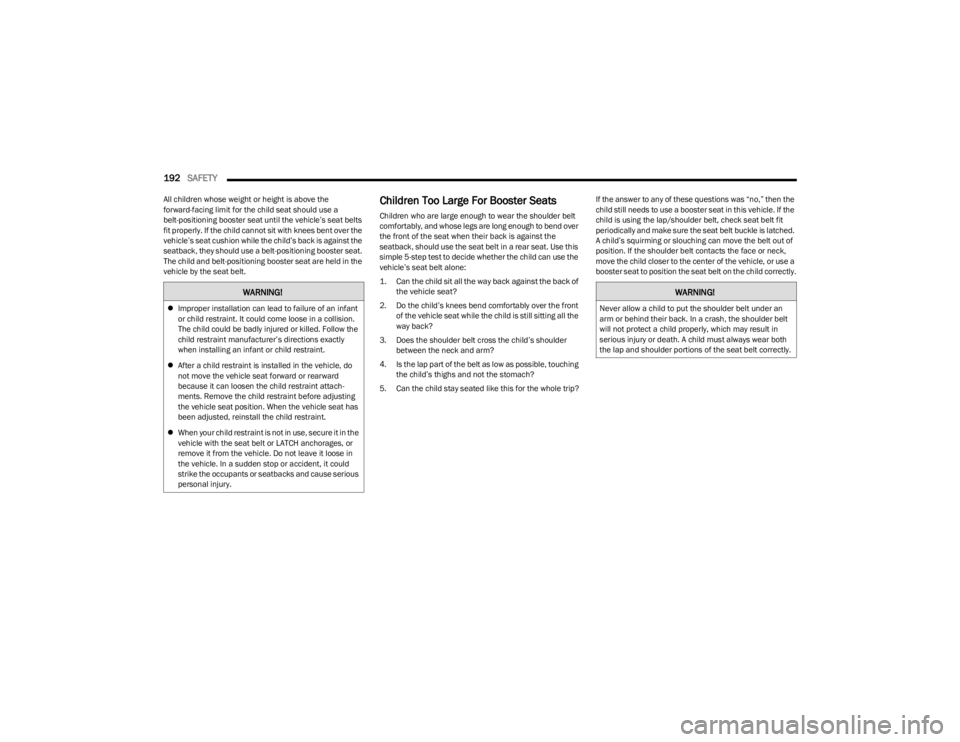
192SAFETY
All children whose weight or height is above the
forward-facing limit for the child seat should use a
belt-positioning booster seat until the vehicle’s seat belts
fit properly. If the child cannot sit with knees bent over the
vehicle’s seat cushion while the child’s back is against the
seatback, they should use a belt-positioning booster seat.
The child and belt-positioning booster seat are held in the
vehicle by the seat belt.Children Too Large For Booster Seats
Children who are large enough to wear the shoulder belt
comfortably, and whose legs are long enough to bend over
the front of the seat when their back is against the
seatback, should use the seat belt in a rear seat. Use this
simple 5-step test to decide whether the child can use the
vehicle’s seat belt alone:
1. Can the child sit all the way back against the back of
the vehicle seat?
2. Do the child’s knees bend comfortably over the front of the vehicle seat while the child is still sitting all the
way back?
3. Does the shoulder belt cross the child’s shoulder between the neck and arm?
4. Is the lap part of the belt as low as possible, touching the child’s thighs and not the stomach?
5. Can the child stay seated like this for the whole trip? If the answer to any of these questions was “no,” then the
child still needs to use a booster seat in this vehicle. If the
child is using the lap/shoulder belt, check seat belt fit
periodically and make sure the seat belt buckle is latched.
A child’s squirming or slouching can move the belt out of
position. If the shoulder belt contacts the face or neck,
move the child closer to the center of the vehicle, or use a
booster seat to position the seat belt on the child correctly.
WARNING!
Improper installation can lead to failure of an infant
or child restraint. It could come loose in a collision.
The child could be badly injured or killed. Follow the
child restraint manufacturer’s directions exactly
when installing an infant or child restraint.
After a child restraint is installed in the vehicle, do
not move the vehicle seat forward or rearward
because it can loosen the child restraint attach-
ments. Remove the child restraint before adjusting
the vehicle seat position. When the vehicle seat has
been adjusted, reinstall the child restraint.
When your child restraint is not in use, secure it in the
vehicle with the seat belt or LATCH anchorages, or
remove it from the vehicle. Do not leave it loose in
the vehicle. In a sudden stop or accident, it could
strike the occupants or seatbacks and cause serious
personal injury.
WARNING!
Never allow a child to put the shoulder belt under an
arm or behind their back. In a crash, the shoulder belt
will not protect a child properly, which may result in
serious injury or death. A child must always wear both
the lap and shoulder portions of the seat belt correctly.
23_LD_OM_EN_USC_t.book Page 192
Page 195 of 292
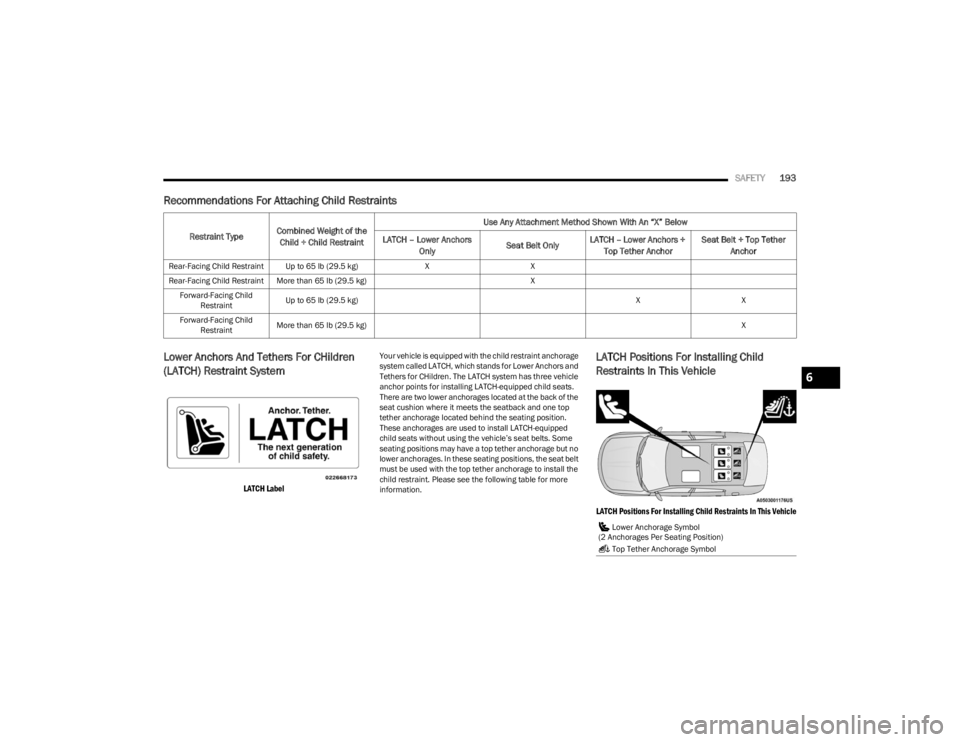
SAFETY193
Recommendations For Attaching Child Restraints
Lower Anchors And Tethers For CHildren
(LATCH) Restraint System
LATCH Label
Your vehicle is equipped with the child restraint anchorage
system called LATCH, which stands for Lower Anchors and
Tethers for CHildren. The LATCH system has three vehicle
anchor points for installing LATCH-equipped child seats.
There are two lower anchorages located at the back of the
seat cushion where it meets the seatback and one top
tether anchorage located behind the seating position.
These anchorages are used to install LATCH-equipped
child seats without using the vehicle’s seat belts. Some
seating positions may have a top tether anchorage but no
lower anchorages. In these seating positions, the seat belt
must be used with the top tether anchorage to install the
child restraint. Please see the following table for more
information.LATCH Positions For Installing Child
Restraints In This Vehicle
LATCH Positions For Installing Child Restraints In This Vehicle
Restraint Type
Combined Weight of the
Child + Child Restraint Use Any Attachment Method Shown With An “X” Below
LATCH – Lower Anchors Only Seat Belt OnlyLATCH – Lower Anchors +
Top Tether Anchor Seat Belt + Top Tether
Anchor
Rear-Facing Child Restraint Up to 65 lb (29.5 kg) XX
Rear-Facing Child Restraint More than 65 lb (29.5 kg) X
Forward-Facing Child Restraint Up to 65 lb (29.5 kg)
XX
Forward-Facing Child Restraint More than 65 lb (29.5 kg)
X
Lower Anchorage Symbol
(2 Anchorages Per Seating Position)
Top Tether Anchorage Symbol
6
23_LD_OM_EN_USC_t.book Page 193
Page 196 of 292
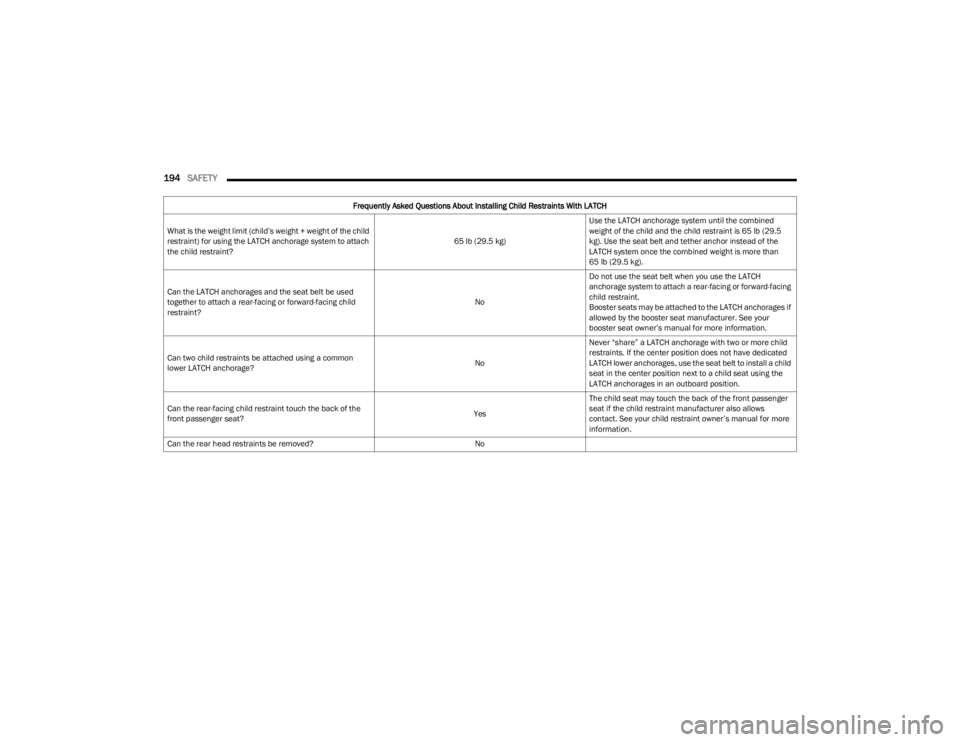
194SAFETY
Frequently Asked Questions About Installing Child Restraints With LATCH
What is the weight limit (child’s weight + weight of the child
restraint) for using the LATCH anchorage system to attach
the child restraint? 65 lb (29.5 kg)Use the LATCH anchorage system until the combined
weight of the child and the child restraint is 65 lb (29.5
kg). Use the seat belt and tether anchor instead of the
LATCH system once the combined weight is more than
65 lb (29.5 kg).
Can the LATCH anchorages and the seat belt be used
together to attach a rear-facing or forward-facing child
restraint? NoDo not use the seat belt when you use the LATCH
anchorage system to attach a rear-facing or forward-facing
child restraint.
Booster seats may be attached to the LATCH anchorages if
allowed by the booster seat manufacturer. See your
booster seat owner’s manual for more information.
Can two child restraints be attached using a common
lower LATCH anchorage? NoNever “share” a LATCH anchorage with two or more child
restraints. If the center position does not have dedicated
LATCH lower anchorages, use the seat belt to install a child
seat in the center position next to a child seat using the
LATCH anchorages in an outboard position.
Can the rear-facing child restraint touch the back of the
front passenger seat? YesThe child seat may touch the back of the front passenger
seat if the child restraint manufacturer also allows
contact. See your child restraint owner’s manual for more
information.
Can the rear head restraints be removed? No
23_LD_OM_EN_USC_t.book Page 194
Page 199 of 292
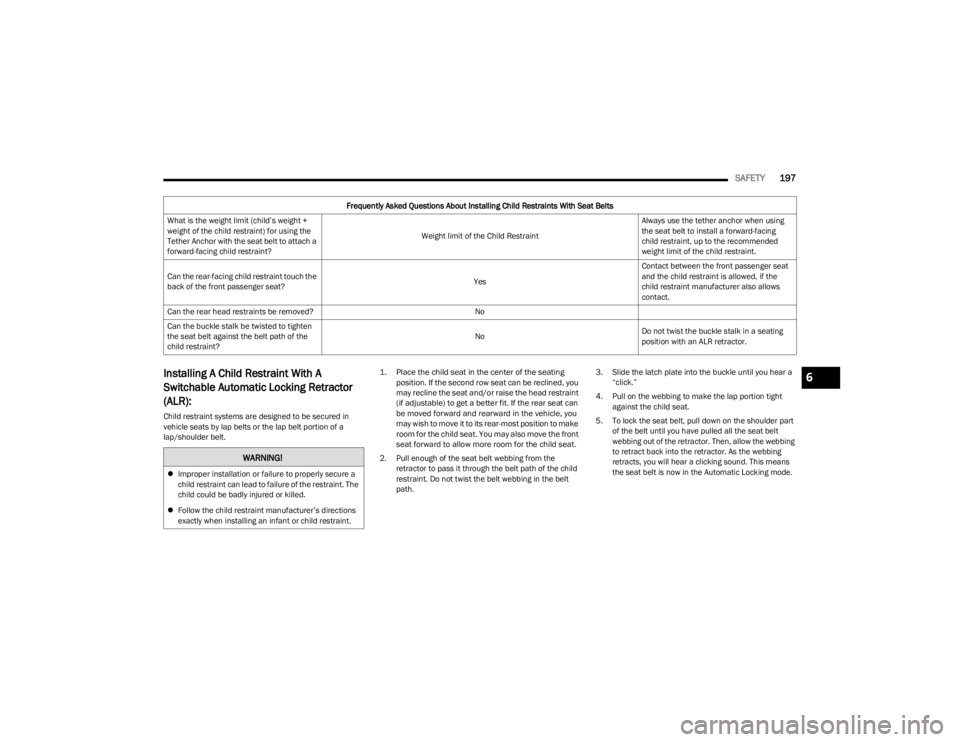
SAFETY197
Installing A Child Restraint With A
Switchable Automatic Locking Retractor
(ALR):
Child restraint systems are designed to be secured in
vehicle seats by lap belts or the lap belt portion of a
lap/shoulder belt.
1. Place the child seat in the center of the seating
position. If the second row seat can be reclined, you
may recline the seat and/or raise the head restraint
(if adjustable) to get a better fit. If the rear seat can
be moved forward and rearward in the vehicle, you
may wish to move it to its rear-most position to make
room for the child seat. You may also move the front
seat forward to allow more room for the child seat.
2. Pull enough of the seat belt webbing from the retractor to pass it through the belt path of the child
restraint. Do not twist the belt webbing in the belt
path. 3. Slide the latch plate into the buckle until you hear a
“click.”
4. Pull on the webbing to make the lap portion tight against the child seat.
5. To lock the seat belt, pull down on the shoulder part of the belt until you have pulled all the seat belt
webbing out of the retractor. Then, allow the webbing
to retract back into the retractor. As the webbing
retracts, you will hear a clicking sound. This means
the seat belt is now in the Automatic Locking mode.
Frequently Asked Questions About Installing Child Restraints With Seat Belts
What is the weight limit (child’s weight +
weight of the child restraint) for using the
Tether Anchor with the seat belt to attach a
forward-facing child restraint? Weight limit of the Child RestraintAlways use the tether anchor when using
the seat belt to install a forward-facing
child restraint, up to the recommended
weight limit of the child restraint.
Can the rear-facing child restraint touch the
back of the front passenger seat? YesContact between the front passenger seat
and the child restraint is allowed, if the
child restraint manufacturer also allows
contact.
Can the rear head restraints be removed? No
Can the buckle stalk be twisted to tighten
the seat belt against the belt path of the
child restraint? No
Do not twist the buckle stalk in a seating
position with an ALR retractor.
WARNING!
Improper installation or failure to properly secure a
child restraint can lead to failure of the restraint. The
child could be badly injured or killed.
Follow the child restraint manufacturer’s directions
exactly when installing an infant or child restraint.
6
23_LD_OM_EN_USC_t.book Page 197
Page 254 of 292

252SERVICING AND MAINTENANCE
Tire Loading And Tire Pressure
NOTE:The proper cold tire inflation pressure is listed on the
driver’s side B-pillar or the rear edge of the driver's side
door.
Check the inflation pressure of each tire, including the
spare tire (if equipped), at least monthly and inflate to the
recommended pressure for your vehicle.
Example Tire Placard Location (Door) Example Tire Placard Location (B-pillar)
Tire And Loading Information Placard
Tire And Loading Information Placard
This placard tells you important information about the:
1. Number of people that can be carried in the vehicle.
2. Total weight your vehicle can carry.
3. Tire size designed for your vehicle.
4. Cold tire inflation pressures for the front, rear, and
spare tires.
Loading
The vehicle maximum load on the tire must not exceed the
load carrying capacity of the tire on your vehicle. You will
not exceed the tire's load carrying capacity if you adhere to
the loading conditions, tire size, and cold tire inflation
pressures specified on the Tire And Loading Information
Placard
Úpage 102.
NOTE:Under a maximum loaded vehicle condition, Gross Axle
Weight Rating (GAWR) for the front and rear axles must
not be exceeded.
For further information on GAWR, vehicle loading, and
trailer towing
Úpage 102.
To determine the maximum loading conditions of your
vehicle, locate the statement “The combined weight of
occupants and cargo should never exceed XXX kg or XXX
lbs” on the Tire And Loading Information Placard. The
combined weight of occupants, cargo/luggage and trailer
tongue weight (if applicable) should never exceed the
weight referenced here.
23_LD_OM_EN_USC_t.book Page 252
Page 255 of 292
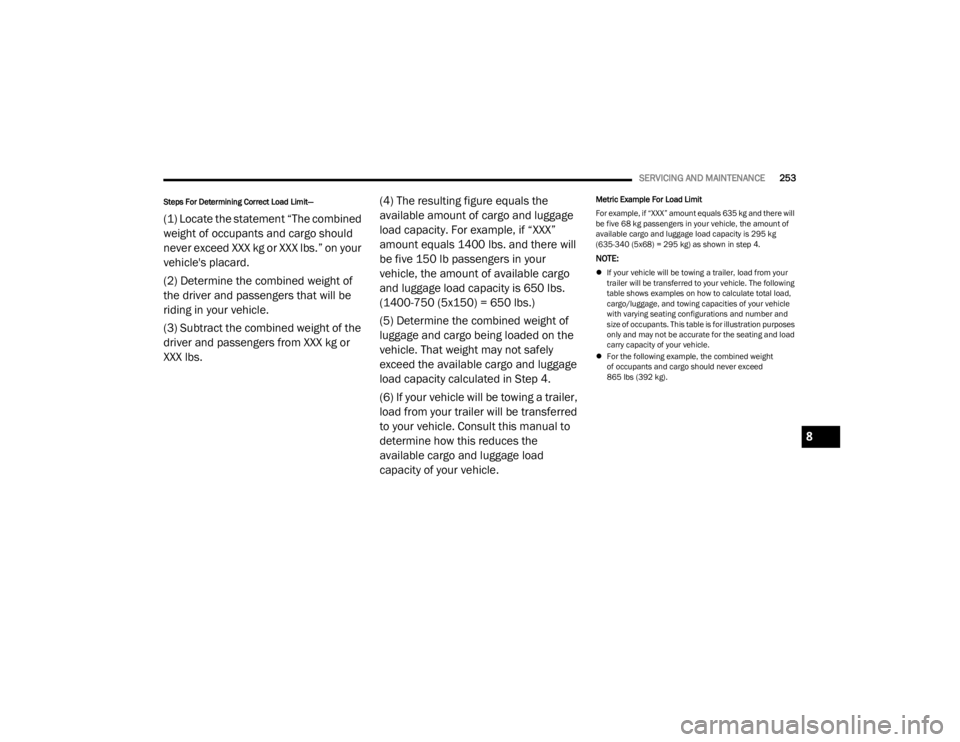
SERVICING AND MAINTENANCE253
Steps For Determining Correct Load Limit—
(1) Locate the statement “The combined
weight of occupants and cargo should
never exceed XXX kg or XXX lbs.” on your
vehicle's placard.
(2) Determine the combined weight of
the driver and passengers that will be
riding in your vehicle.
(3) Subtract the combined weight of the
driver and passengers from XXX kg or
XXX lbs. (4) The resulting figure equals the
available amount of cargo and luggage
load capacity. For example, if “XXX”
amount equals 1400 lbs. and there will
be five 150 lb passengers in your
vehicle, the amount of available cargo
and luggage load capacity is 650 lbs.
(1400-750 (5x150) = 650 lbs.)
(5) Determine the combined weight of
luggage and cargo being loaded on the
vehicle. That weight may not safely
exceed the available cargo and luggage
load capacity calculated in Step 4.
(6) If your vehicle will be towing a trailer,
load from your trailer will be transferred
to your vehicle. Consult this manual to
determine how this reduces the
available cargo and luggage load
capacity of your vehicle.
Metric Example For Load Limit
For example, if “XXX” amount equals 635 kg and there will
be five 68 kg passengers in your vehicle, the amount of
available cargo and luggage load capacity is 295 kg
(635-340 (5x68) = 295 kg) as shown in step 4.
NOTE:
If your vehicle will be towing a trailer, load from your
trailer will be transferred to your vehicle. The following
table shows examples on how to calculate total load,
cargo/luggage, and towing capacities of your vehicle
with varying seating configurations and number and
size of occupants. This table is for illustration purposes
only and may not be accurate for the seating and load
carry capacity of your vehicle.
For the following example, the combined weight
of occupants and cargo should never exceed
865 lbs (392 kg).
8
23_LD_OM_EN_USC_t.book Page 253
Page 283 of 292

281
Gross Axle Weight Rating ................................... 102, 103
Gross Vehicle Weight Rating .............................. 102, 103
GVWR ............................................................................ 102
HHazard Driving Through Flowing, Rising, OrShallow Standing Water .................................... 110
Hazard Warning Flashers ............................................ 202
Head Restraints .............................................................. 33
Head Rests ...................................................................... 33
Headlights Automatic ...................................................................42
Cleaning................................................................... 265
High Beam/Low Beam Select Switch .......................41
Lights On Reminder ...................................................42
On With Wipers ..........................................................42
Passing ....................................................................... 42
Switch .........................................................................40
Time Delay..................................................................42
Washers................................................................... 227
Heated Mirrors ................................................................36 High Beam/Low Beam Select (Dimmer) Switch ...........41
Hill Start Assist ............................................................. 167
Hitches Trailer Towing .......................................................... 105
Holder, Coin .....................................................................53
HomeLink (Garage Door Opener) ..................................36
Hood Prop ........................................................................59 Hood Release ..................................................................59
IIgnition............................................................................. 15 Switch......................................................................... 15
Illuminated Cupholder .................................................... 54 Indicator Lights Blue ............................................................................ 74
Green.......................................................................... 73
White .......................................................................... 74
Yellow ......................................................................... 73
Information Center, Vehicle ........................................... 64
Inside Rearview Mirror ................................... 34
, 35, 202
Instrument Cluster ................................................... 61, 63
Descriptions ............................................................... 74
Display................................................................. 63
, 65
Instrument Cluster
b
................................................... 63
Instrument Panel Lens Cleaning ................................. 266
Interior Appearance Care ............................................. 265
Interior Lights .................................................................. 43
JJack Location ................................................................ 206
Jacking And Tire Changing — If Equipped
b
............. 205
Jump Starting ...................................................... 213, 214
KKey Fob Arm The System......................................................... 19
Panic Alarm ................................................................ 13
Programming Additional Key Fobs ........................... 14
Unlatch The Trunk ..................................................... 13
Key Fob Battery Service (Remote Keyless Entry) ......... 13 Key Fob Programming (Remote Keyless Entry)............ 14
Keyless Enter 'n Go™ .............................................. 22
, 78
Enter The Trunk......................................................... 13
Passive Entry ............................................................. 22
Passive Entry Programming ..................................... 22
Keys ................................................................................. 12
LLane Change And Turn Signals ..................................... 43
Lane Change Assist ........................................................ 43 LaneSense ...................................................................... 98Lap/Shoulder Belts ...................................................... 178
Latches ......................................................................... 201 Hood........................................................................... 59
Lead Free Gasoline ...................................................... 268
Leaks, Fluid................................................................... 201
Life Of Tires ................................................................... 257
Light Bulbs ...........................................................201
, 246
Lights ............................................................................. 201 Adaptive Cruise Control (ACC) Set WithTarget Vehicle ...................................................... 73
Adaptive Cruise Control (ACC) Set Without Target Vehicle ...................................................... 73
Air Bag...................................................... 68
, 183, 200
Automatic Headlights ............................................... 42
Brake Assist Warning.............................................. 167
Brake Warning.................................................. 68
, 267
Bulb Replacement .................................................. 246
Cruise .................................................................. 73
, 74
Daytime Running....................................................... 41
Dimmer Switch, Headlight ........................................ 41
11
23_LD_OM_EN_USC_t.book Page 281
Page 287 of 292
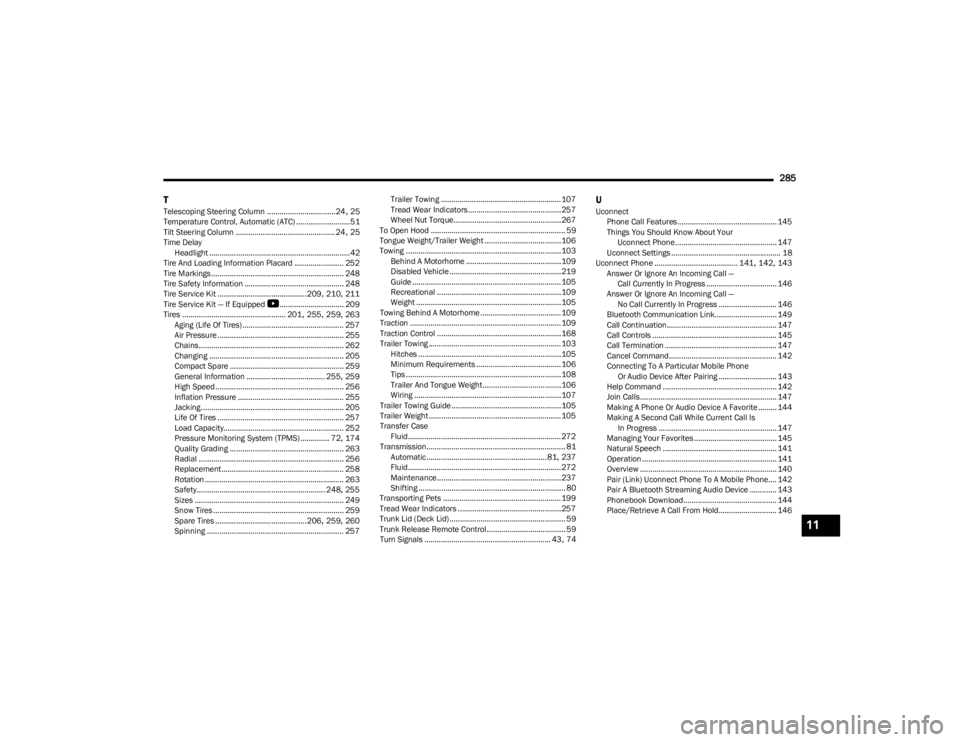
285
T
Telescoping Steering Column .................................24, 25
Temperature Control, Automatic (ATC) ..........................51
Tilt Steering Column ................................................ 24
, 25
Time Delay Headlight ....................................................................42
Tire And Loading Information Placard ........................ 252
Tire Markings................................................................ 248
Tire Safety Information ................................................ 248
Tire Service Kit ...........................................209
, 210, 211
Tire Service Kit — If Equipped
b
............................... 209
Tires .................................................. 201, 255, 259, 263
Aging (Life Of Tires)................................................. 257 Air Pressure ............................................................. 255
Chains...................................................................... 262Changing ................................................................. 205
Compact Spare ....................................................... 259
General Information ...................................... 255
, 259
High Speed .............................................................. 256
Inflation Pressure ................................................... 255
Jacking..................................................................... 205
Life Of Tires ............................................................. 257
Load Capacity.......................................................... 252
Pressure Monitoring System (TPMS) .............. 72
, 174
Quality Grading ....................................................... 263
Radial ...................................................................... 256 Replacement ........................................................... 258
Rotation ................................................................... 263
Safety.............................................................. 248
, 255
Sizes ........................................................................ 249
Snow Tires ............................................................... 259 Spare Tires ............................................206
, 259, 260
Spinning .................................................................. 257 Trailer Towing .......................................................... 107
Tread Wear Indicators ............................................. 257
Wheel Nut Torque....................................................267
To Open Hood ................................................................. 59
Tongue Weight/Trailer Weight ..................................... 106
Towing ...........................................................................103 Behind A Motorhome .............................................. 109Disabled Vehicle ...................................................... 219
Guide ........................................................................ 105
Recreational ............................................................109Weight ...................................................................... 105
Towing Behind A Motorhome ....................................... 109
Traction ......................................................................... 109
Traction Control ............................................................168
Trailer Towing ................................................................ 103 Hitches .....................................................................105
Minimum Requirements ......................................... 106
Tips ...........................................................................108Trailer And Tongue Weight...................................... 106Wiring ....................................................................... 107
Trailer Towing Guide ..................................................... 105
Trailer Weight ................................................................ 105
Transfer Case Fluid.......................................................................... 272
Transmission................................................................... 81 Automatic ..........................................................81
, 237
Fluid.......................................................................... 272 Maintenance............................................................237Shifting ....................................................................... 80
Transporting Pets ......................................................... 199
Tread Wear Indicators ..................................................257
Trunk Lid (Deck Lid)........................................................ 59
Trunk Release Remote Control...................................... 59 Turn Signals ............................................................. 43
, 74
UUconnect Phone Call Features................................................ 145Things You Should Know About Your Uconnect Phone................................................. 147
Uconnect Settings ..................................................... 18
Uconnect Phone ........................................ 141
, 142, 143
Answer Or Ignore An Incoming Call — Call Currently In Progress .................................. 146
Answer Or Ignore An Incoming Call — No Call Currently In Progress ............................ 146
Bluetooth Communication Link.............................. 149
Call Continuation..................................................... 147
Call Controls ............................................................ 145
Call Termination ...................................................... 147
Cancel Command.................................................... 142
Connecting To A Particular Mobile Phone Or Audio Device After Pairing ............................ 143
Help Command ....................................................... 142 Join Calls.................................................................. 147
Making A Phone Or Audio Device A Favorite ......... 144
Making A Second Call While Current Call Is In Progress ......................................................... 147
Managing Your Favorites ........................................ 145 Natural Speech ....................................................... 141Operation ................................................................. 141
Overview .................................................................. 140
Pair (Link) Uconnect Phone To A Mobile Phone.... 142
Pair A Bluetooth Streaming Audio Device ............. 143Phonebook Download............................................. 144
Place/Retrieve A Call From Hold............................ 146
11
23_LD_OM_EN_USC_t.book Page 285